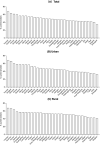Trends in smoking prevalence in urban and rural China, 2007 to 2018: Findings from 5 consecutive nationally representative cross-sectional surveys
- PMID: 36006870
- PMCID: PMC9409540
- DOI: 10.1371/journal.pmed.1004064
Trends in smoking prevalence in urban and rural China, 2007 to 2018: Findings from 5 consecutive nationally representative cross-sectional surveys
Abstract
Background: Tobacco smoking is a leading cause of premature death in China, especially among adult men. Since the implementation of the Framework Convention on Tobacco Control in 2005, nationwide tobacco control has been strengthened, but its long-term impact on smoking prevalence is unclear.
Methods and findings: Five nationally representative surveys of the China Chronic Disease and Risk Factor Surveillance (CCDRFS) were conducted in 2007, 2010, 2013, 2015, and 2018. A total of 624,568 adults (278,605 men and 345,963 women) aged 18 to 69 years were randomly selected from 31 provinces (or equivalent) in China. Temporal changes in smoking prevalence and patterns (e.g., percentages of those smoking manufactured cigarettes, amount smoked, and age at smoking initiation) were analyzed, overall and by sex, urban or rural residence, year of birth, education and occupation, using linear regression methods. Among men, the standardized prevalence of current smoking decreased from 58.4% (95% confidence interval [CI]: 56.1 to 60.7) to 50.8% (95% CI: 49.1 to 52.5, p < 0.001) between 2007 and 2018, with annual decrease more pronounced in urban (55.7% [95% CI: 51.2 to 60.3] to 46.3% [95% CI: 43.7 to 49.0], p < 0.001) than rural men (59.9% [95% CI: 57.5 to 62.4] to 54.6% [95% CI: 52.6 to 56.6], p = 0.05) and in those born before than after 1980. Among rural men born after 1990, however, the prevalence increased from 40.2% [95% CI: 34.0 to 46.4] to 52.1% ([95% CI: 45.7 to 58.5], p = 0.007), with the increase taking place mainly before 2015. Among women, smoking prevalence remained extremely low at around 2% during 2007 to 2018. No significant changes of current smoking prevalence (53.9% to 50.8%, p = 0.22) were observed in male patients with at least 1 of major chronic diseases (e.g., hypertension, diabetes, myocardial infarction, stroke, chronic obstructive pulmonary disease (COPD)). In 2018, 25.6% of adults aged ≥18 years smoked, translating into an estimated 282 million smokers (271 million men and 11 million women) in China. Across 31 provinces, smoking prevalence varied greatly. The 3 provinces (Yunnan, Guizhou, and Hunan) with highest per capita tobacco production had highest smoking prevalence in men (68.0%, 63.4%, and 61.5%, respectively), while lowest prevalence was observed in Shanghai (34.8%). Since the children and teenage groups were not included in the surveys, we could not assess the smoking trends among youths. Furthermore, since the smoking behavior was self-reported, the smoking prevalence could be underestimated due to reporting bias.
Conclusions: In this study, we observed that the smoking prevalence has decreased steadily in recent decades in China, but there were diverging trends between urban and rural areas, especially among men born after 1980. Future tobacco control strategies should target rural young men, regions with high tobacco production, and patients suffering from chronic diseases.
Conflict of interest statement
The authors have no competing interests to declare.
Figures




Similar articles
-
Prevalence of Smoking and Knowledge About the Hazards of Smoking Among 170 000 Chinese Adults, 2013-2014.Nicotine Tob Res. 2019 Nov 19;21(12):1644-1651. doi: 10.1093/ntr/ntz020. Nicotine Tob Res. 2019. PMID: 30759252
-
Body-mass index and obesity in urban and rural China: findings from consecutive nationally representative surveys during 2004-18.Lancet. 2021 Jul 3;398(10294):53-63. doi: 10.1016/S0140-6736(21)00798-4. Lancet. 2021. PMID: 34217401 Free PMC article.
-
Contrasting male and female trends in tobacco-attributed mortality in China: evidence from successive nationwide prospective cohort studies.Lancet. 2015 Oct 10;386(10002):1447-56. doi: 10.1016/S0140-6736(15)00340-2. Lancet. 2015. PMID: 26466050 Free PMC article. Review.
-
E-cigarette use among adults in China: findings from repeated cross-sectional surveys in 2015-16 and 2018-19.Lancet Public Health. 2020 Dec;5(12):e639-e649. doi: 10.1016/S2468-2667(20)30145-6. Lancet Public Health. 2020. PMID: 33271077
-
Tobacco use in 3 billion individuals from 16 countries: an analysis of nationally representative cross-sectional household surveys.Lancet. 2012 Aug 18;380(9842):668-79. doi: 10.1016/S0140-6736(12)61085-X. Lancet. 2012. PMID: 22901888 Review.
Cited by
-
Comparison of Three Prediction Models for Predicting Chronic Obstructive Pulmonary Disease in China.Int J Chron Obstruct Pulmon Dis. 2023 Dec 12;18:2961-2969. doi: 10.2147/COPD.S431115. eCollection 2023. Int J Chron Obstruct Pulmon Dis. 2023. PMID: 38107597 Free PMC article.
-
Integrative analysis of genetics, epigenetics and RNA expression data reveal three susceptibility loci for smoking behavior in Chinese Han population.Mol Psychiatry. 2024 Nov;29(11):3516-3526. doi: 10.1038/s41380-024-02599-1. Epub 2024 May 24. Mol Psychiatry. 2024. PMID: 38789676
-
Efficacy of WeChat-based online smoking cessation intervention ('WeChat WeQuit') in China: a randomised controlled trial.EClinicalMedicine. 2023 May 18;60:102009. doi: 10.1016/j.eclinm.2023.102009. eCollection 2023 Jun. EClinicalMedicine. 2023. PMID: 37251625 Free PMC article.
-
Trends in mortality due to tracheal, bronchial, and lung cancer across the BRICS: An age-period-cohort analysis based on the Global Burden of Disease Study 1990-2019.Chin Med J (Engl). 2024 Dec 5;137(23):2860-2867. doi: 10.1097/CM9.0000000000002977. Epub 2024 Feb 5. Chin Med J (Engl). 2024. PMID: 38311810 Free PMC article.
-
Profiles of Cough and Associated Risk Factors in Nonhospitalized Individuals With SARS-CoV-2 Omicron Variant Infection: Cross-Sectional Online Survey in China.JMIR Public Health Surveill. 2024 Feb 5;10:e47453. doi: 10.2196/47453. JMIR Public Health Surveill. 2024. PMID: 38315527 Free PMC article.
References
-
- World Health Organization. Noncommunicable disease country profiles 2018. Geneva: World Health Organization; 2018.
-
- Langenbrunner JC, Marquez PW, Wang S. Toward a healthy and harmonious life in China: stemming the rising tide of noncommunicable diseases. Washington D.C.: World Bank.
-
- GBD 2019 Tobacco Collaborators. Spatial, temporal, and demographic patterns in prevalence of smoking tobacco use and attributable disease burden in 204 countries and territories, 1990–2019: a systematic analysis from the Global Burden of Disease Study 2019. Lancet. 2021;397(10292):2337–2360. doi: 10.1016/S0140-6736(21)01169-7 - DOI - PMC - PubMed
MeSH terms
Grants and funding
LinkOut - more resources
Full Text Sources
Medical

